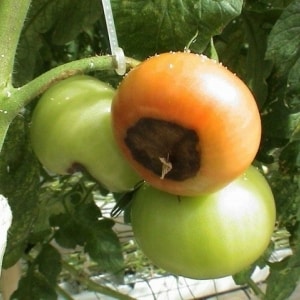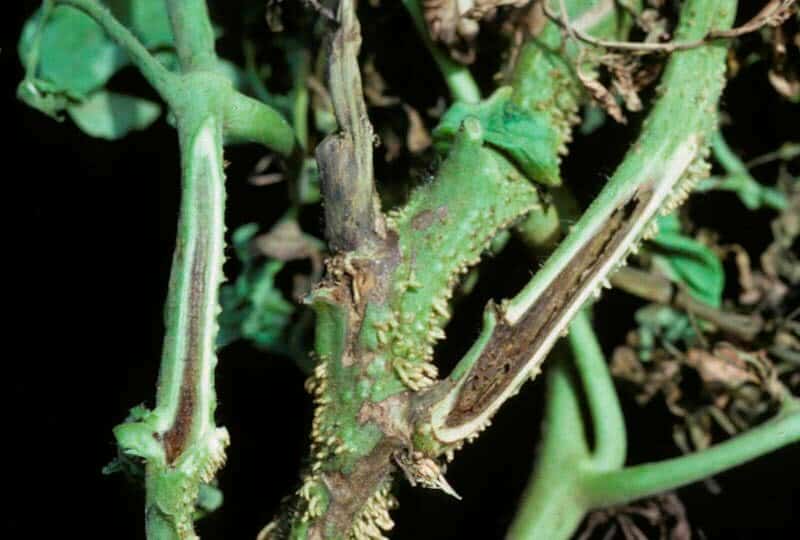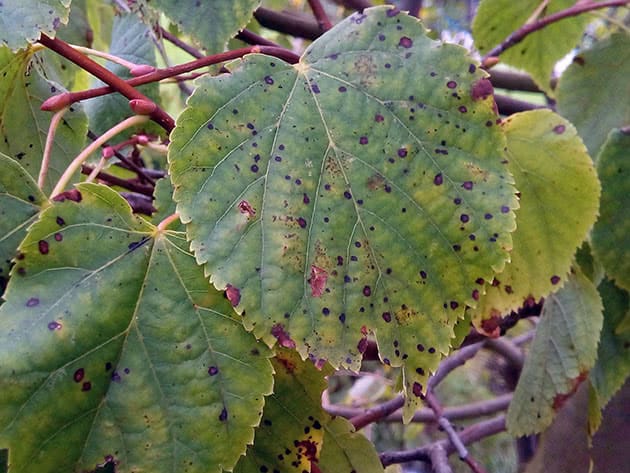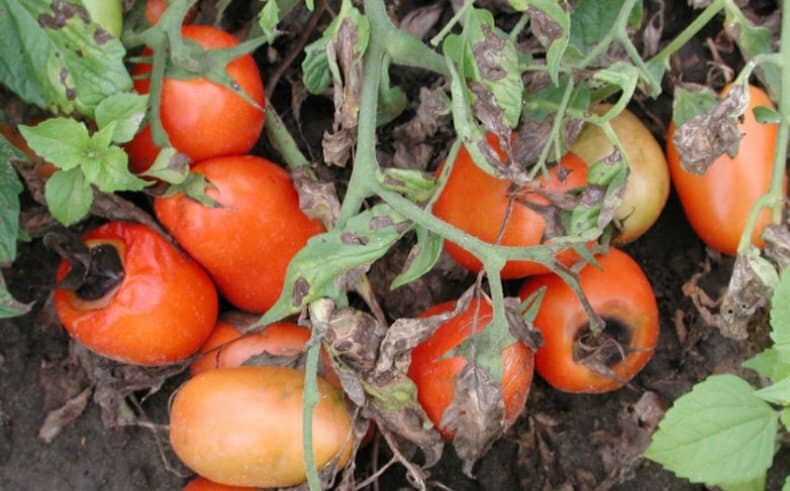We find the cause and effectively fight it: what to do if tomatoes turn black on the bottom and how to prevent the problem
Every summer, gardeners are faced with a problem - tomatoes turn black on the bottom. Just yesterday the bushes were healthy, developing and growing, but today there are black spots on the fruits, leaves, and stems. There are many reasons for this phenomenon: fungal diseases, infections, violation of cultivation technology, unfavorable weather conditions and others.
On this page we will answer the question of how to grow tomatoes without loss. You will learn how to solve the problem of blackening of tomatoes, what methods of control are available. Experienced gardeners will share their secrets for growing tomatoes.
Why tomatoes turn black and what to do about it
The tomato belongs to the nightshade family, relatives include potatoes, eggplants, and peppers. Growing these crops requires adherence to agricultural technology: climatic and weather conditions and soil conditions should be taken into account. The technology of care depends on the place of growth of the crop.
There are many reasons why dark spots appear on tomato fruits, the first being diseases.
Diseases of nightshade plants:
- late blight;
- gray rot;
- stem necrosis;
- crown rot;
- Alternaria blight (macrosporiasis, brown, dry, brown spot);
- watery rot;
- anthracnose
Let's look at each one in detail.
Phytophthora as a cause of blackening of tomatoes
Late blight is a genus of fungus-like organisms that cause the disease late blight. It affects the leaves, brown spots appear on them, then a white coating.If you do not fight the lesions, the plantation disappears within a week. The disease is not immediately visible on the fruits, but as they ripen, brown spots appear that quickly spread, and the fruits begin to rot.
Causes of late blight:
- High air humidity, fog, dew.
- Sudden changes in day and night temperatures.
- Tight fit.
- Rainy weather.
- Closed space.
- Presence of pathogenic microbes in the soil.
- Seeds with infections.
- Neighborhood with potatoes, eggplants, peppers.
- Lack of copper salts in the soil.
- Violation of agricultural technology.
The problem can be dealt with using chemical And folk methods of struggle.
Apical rot
The disease is not an infection; it appears as a result of dry weather or improper care of tomatoes, for example, overheating in a greenhouse. A brown flat spot forms at the top of the fruit, which gradually increases in size. The bush dries out, the fruits lose moisture and elasticity.
Reasons why blossom end rot develops:
- the amount of nitrogen in the soil exceeds the norm;
- increased acidity;
- excess or deficiency of calcium.
Control measures with the problem:
- Fertilize tomatoes with potassium sulfate. To do this, dissolve a teaspoon of fertilizer in a bucket of water, water the soil and spray the plant.
- Destroy diseased fruits.
- Treat the soil and bushes with boric acid: dissolve a tablespoon of acid in a bucket of water.
Treat once a week until the symptoms of the disease completely disappear.
Gray rot
The disease predominantly develops in closed ground, greenhouses, and when plants are crowded. When infected, grayish-brown spots with a gray coating appear on the bushes. After five days, the spot increases to 5 cm and spreads along the stem.Vascular necrosis forms on the stems, the plant does not receive adequate nutrition and dies.
First aid for gray rot:
- spread charcoal on the plantation;
- sprinkle the bushes with crushed chalk;
- treat with copper sulfate solution;
- use a 1% solution of potassium permanganate for treatment;
- spray the bushes with 1% Bordeaux mixture.
Stem necrosis
The disease begins at the beginning of the season, when the first clusters form. The plant is covered with elongated brown spots. On sections of the stem, damaged vessels are visible, and visible aerial roots appear in the root part. The leaves gradually darken, a net forms on the tomatoes, and when the bush is shaken, the fruits fall off.
Every second plant dies and the disease enters the chronic phase. Removing diseased plants along with the roots will help prevent the spread of the fungus. Stem necrosis bacteria live in seeds and tops. For safety, the ground is disinfected with a solution of potassium permanganate.
Means of protection:
- Preventive treatment of seeds before planting, soak in a 0.25% solution of the drug “Narcissus”.
- Maintaining optimal temperature in greenhouses, ventilation.
- Cleaning up vegetable waste from the garden.
Alternaria blight
This disease is called by other names: macrosporiosis, brown or dry spotting, brown spotting. Plants become covered with brown spots, which gradually increase to 1.5-2 cm. Over time, the leaves die off, and spots with a velvety coating appear on the fruits. The tomatoes fall off green, the surviving fruits are small in size.
The causative agent of Alternaria is a moldy fungus that forms spores and spreads by air; it loves a humid, warm climate. The first signs of the disease appear after planting the seedlings in the ground.Small white spots appear on the lower leaves. After three days, the disease affects the bush.
Control measures:
- If damaged, treat with fungicides.
- Disinfecting the soil with a 1% solution of copper sulfate will help get rid of the fungus.
- Feed the plantation with mineral fertilizers.
- Tie tall varieties to a trellis.
- Mulch the ground under the bushes with pine needles, hay, and straw.
Watery rot
Another scourge that affects tomatoes is the bacterium Erwinia aroidea. It penetrates into tomatoes through cracks in the skin. This is often due to caterpillars and mice damaging the fruits. Bite wounds contain pathogenic bacteria that destroy tissue. Tomatoes darken, become brown in color, and eventually rot, turning into a liquid mass with an unpleasant odor.
It is impossible to fight watery rot with chemicals. The only remedy is prevention. Carry out the following activities in the garden:
- remove plants infected with rot from the site;
- do not allow plantings to thicken;
- carry out pest control;
- choose seeds that are not damaged by bacteria for planting;
- carry out activities to strengthen the immunity of tomatoes.
Brown spot
A fungal disease, a type of Alternaria blight that affects nightshade plants, another name is cladosporiosis. The first signs become noticeable after flowering.
The upper side of the leaves is covered with light spots; a gray or brown coating is visible on the bottom. The leaves dry out quickly, the bush does not receive nutrition and dies. The fight against brown spot begins with treating the bushes with antifungal agents that contain copper.
Important. Chemicals should be stopped a month before harvest.
Preventive measures will help prevent the appearance of brown spot on tomatoes:
- For planting, choose varieties of hybrid tomatoes that are resistant to fungal diseases.
- Before planting, heat treat the seeds, warm them at a temperature of 50˚C.
- Remove the lower branches of bushes regularly.
- Ventilate the greenhouse every day.
- When watering, water should not fall on the leaves.
- Do not allow the soil to dry out.
- Feed tomatoes with potassium or phosphorus fertilizers.
- Do not fertilize with fresh mullein or bird droppings.
- Remove plant debris from the site.
Anthracnose of tomato leaves
An infectious disease that affects adult bushes. Then the fruits become covered with spots with depressions, the upper leaves wither, and the plant is easily pulled out of the ground.
Preparations based on Bacillus subtilis help fight infection; they strengthen plant immunity.
Other reasons for darkening of tomatoes
In addition to diseases, there are other factors that cause darkening of fruits and leaves.
Improper care
Violation of the following growing technologies leads to the death of plants:
- Uneven watering.
- Incorrect feeding. The abundance or lack of nutrients affects tomatoes equally.
- Tight fit.
- Sunburn. Plants that do not have enough foliage are more likely to be damaged. Therefore, if some leaves were removed due to their damage, the plants should be provided with additional shading.
- Acidic soils. Tomatoes grow in neutral and slightly acidic soils.
Dry soil
The optimal humidity for growing tomatoes is 60-70%; they do not tolerate dry soil. During the growing season, tomatoes are watered differently, depending on the stage of growth.
Water thoroughly necessary in two cases:
- during the period of strengthening of seedlings in the soil, during this period the lack of moisture leads to the death of the plantings;
- from the moment of fruit set until fruit ripening.
The rest of the time, water moderately.
Why does it happen that tomatoes turn black in a greenhouse?
Tomatoes are grown in a greenhouse in regions where there is not enough heat and frequent rains. The plants are heat-loving; in cold rainy weather they get sick and disappear. Even in greenhouses, black spots often appear on tomatoes.
Six reasons why tomatoes turn black in a greenhouse and solutions:
- Violation of humidity and temperature conditions leads to the development of fungal diseases. The solution is to water as needed at the root without soaking the leaves.
- Soil salinization occurs when too much fertilizer is applied. The solution is to stop fertilizing.
- The roots are exposed, crawling out, the nutrition is not fully supplied, the tomatoes turn black. The solution is to cover the roots with soil.
- Lack of boron and magnesium in the soil. The solution is to apply fertilizer.
- Fungal infectious diseases. The solution is to treat with Bordeaux mixture or other drugs.
- Lack of ventilation. The solution is to ventilate the greenhouse.
Chemicals and traditional methods in the fight against browning of tomatoes
At the first appearance of black spots on tomatoes, we immediately begin the fight. Some gardeners prefer chemicals, others choose traditional methods.
Chemical treatment methods:
- For minor damage, plantations are treated with 1% Bordeaux mixture solution.
- Severely affected plantations are treated with fungicides: “Topaz”, “Champion”, “Integral” and others.
- The bushes are coated with a fungicide solution: a bucket of water, 300 g of CMC glue, 1 tbsp. spoon of fungicide, 100 g of chalk.
- Trichopolum tablets help in the fight against fungi.Dissolve one tablet in a liter of water and spray three times per season.
- After the seedlings have taken root, they are treated with copper sulfate. Dilute two tablespoons of vitriol in a bucket of water.
- Calcium nitrate easily copes with infections. Dissolve one tablespoon of saltpeter in a bucket of water, spray the stems, leaves, and soil around the plants.
- Fitosporin is used to fight infection. The solution is used to treat the soil and seedlings before planting. Subsequently, the plants are sprayed every 10 days.
- If the plantation is severely damaged, use potassium chloride. Tear off parts of the bush affected by the disease and spray the plant with a 1% solution of potassium chloride.
Attention. Treatment with chemicals is stopped at least a month before harvest.
Folk methods of struggle
- Garlic tincture. Grind 100 g of garlic, add water, let it brew. Dilute the tincture in a bucket of water, add potassium permanganate on the tip of a knife, and spray the tomatoes in the evening or in the morning.
- Serum solution. Dilute the whey in water in a 1:1 ratio. Treat the bushes every day for the first two weeks after planting.
- Milk with iodine. Dilute a liter of milk in 8 liters of water, add 20 drops of iodine, and spray the plantation every two weeks.
- Tincture of rotted straw. Pour water over the straw, add 1 tbsp. spoon of urea, leave for three days, spray twice a season.
- Yeast tincture. Dilute 100 g of yeast in 10 liters of water and water the bushes. Repeat if necessary.
- Salt solution with iodine. Stir a glass of salt in a bucket of water, add 20 g of iodine, process the tomatoes once a month throughout the season.
- Piercing with copper wire. Insert a wire into the hard stem of the tomato.Copper affects chlorophyll and improves air flow into the plant.
Why do picked tomatoes turn black?
It happens like this: you harvested a crop, put it in storage and noticed that the fruits were turning black.
The reasons for this phenomenon:
- Insufficient room ventilation, lack of oxygen.
- Incorrect storage temperature.
- Increased humidity in the room.
- Infection of fruits with anthracnose.
Reference. Anthracnose is a fungal disease that affects the plant at maturity. Tomatoes ripen, become covered with light spots, then darken, soften and disappear.
How to treat tomatoes to prevent them from turning black after harvesting
Experienced gardeners, having noticed the disease, harvest the crop at the ripening stage.
Storage tips:
- It is better to pick tomatoes from the bush if they are brown;
- To ensure that tomatoes ripen without problems after they have been picked from the garden, immerse the fruits in hot water at 60˚C for two minutes. Then dry, wipe and place in boxes until fully ripe;
- Throw away diseased fruits, as they will quickly spoil and infect healthy ones;
- for storage, the fruits are picked together with the stalks;
- green fruits are removed before the temperature at night drops to 5˚C;
- affected fruits are stored separately;
- the harvested crop is kept on balconies, in greenhouses, greenhouses;
- When storing, avoid exposure to direct sunlight;
- crops for storage are placed in boxes or on boards;
- ventilate the room, make sure that the humidity does not exceed 80%;
- fruits ripen faster at a temperature of 25˚C.
Preventive measures
Follow agricultural cultivation techniques and you will avoid the appearance of dark spots on tomatoes. Prevention is the right remedy in the fight against disease.
Nine steps of prevention:
- Plant tomatoes in the same place no earlier than after three years.
- Do not use soil after potatoes, eggplants, and peppers.
- Do not plant tomatoes next to potatoes.
- For planting, choose wind-blown, sunny areas.
- Plant bushes at a distance of 40 cm.
- Pinching and pinching.
- Water moderately, do not over-water, and do not allow the soil to dry out.
- Remove plants with diseased leaves and fruits.
- Harvest on time.
How to prevent the disease from spreading next year
The problem is easier to prevent than to fight. You notice damaged fruits, blackened leaves, and dried stems in the garden, which means the tomatoes are sick. Prevent the infection from spreading next year.
Precautionary measures:
- plant marigolds, mustard, and calendula in the garden, which prevent the spread of diseases;
- disinfect the soil with a 1% solution of potassium permanganate;
- remove plant waste from the garden;
- prepare healthy seeds for planting;
- choose varieties that are resistant to infections;
- mulch the ground with pine needles, straw, hay;
- treat the greenhouse with a 1% solution of copper sulfate.
Recommendations from gardeners
Experienced farmers have learned to cope with tomato diseases, and everyone has their own secrets.
Kate: «In the greenhouse we fight late blight in this way: we water it once or twice a week, and constantly mulch the soil to retain moisture. The method of warming up the greenhouse helps get rid of fungi. In hot weather, we close the greenhouse for a couple of hours; late blight does not like this.”
Sergey: «I grow tomatoes in a greenhouse and recently noticed black spots on the bushes. To preserve the harvest, we had to pick off the green fruits. For disinfection purposes, I soaked it in hot water at 60˚C for two minutes and stored it in boxes. Copper sulfate was splashed in the greenhouse.”
Ivan: «I fight tomato disease in my grandmother’s way - I spray it with milk and iodine. As soon as I notice signs of disease, I pick off all the fruits. Then I prepare a solution: I dissolve a small bottle of iodine in a bucket of warm water. I immerse tomatoes without cuttings in the solution for 20 minutes, take them out, dry them and store them in boxes. I water the ground and bushes with a solution of milk and iodine.”
Conclusion
There are many reasons why tomato fruits begin to turn black. The main influencing factors include fungal and bacterial diseases. Another group of reasons is improper care, violation of watering and nutritional regimes. Treating plant diseases is more difficult than preventing them. To prevent the development of pathologies, follow the prevention methods described in the article.